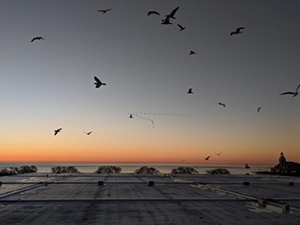Nuisance Bird Management for Water Treatment Facilities
Jun 25, 2024
High water quality is foundational to both environmental health and human well-being. While the impact of industrial pollutants and agricultural runoff on water quality are often discussed, the role of wildlife – and migratory birds, in particular – is often overlooked.
This blog explores how birds affect water quality and outlines how water treatment facilities can best address these issues.
The Damage Nuisance Birds Inflict on Water Treatment Facilities
Birds and evidence of their presence (e.g., nesting materials, fecal droppings) have a direct impact on bodies of water and treatment facilities in the following ways.
Water Contamination
Birds, especially waterfowl such as Canada geese and gulls, can introduce organic contaminants and pathogens into bodies of water through their fecal droppings. Bird droppings are rich in nitrogen and phosphorus, nutrients that can lead to eutrophication. Eutrophication promotes the growth of algae and aquatic plants, potentially resulting in harmful algae blooms which can produce toxins harmful to both aquatic life and human health.
Further, many bird species harbor bacteria such as E. coli and Salmonella, which can be spread through their droppings and contaminate water sources. This contamination poses human health risks and complicates water treatment processes. For example, the unmanaged gull presence on Chicago beaches has led to increased E. coli bacteria levels in Lake Michigan, resulting in prolonged closures for certain beaches.
Property & Asset Damage
Birds can also physically impact water treatment facility infrastructure. When birds nest on rooftops, equipment, or assets, they can cause blockages, damage, and operational inefficiencies. Bird-related damage and underperformance can lead to increased maintenance costs and downtime for repairs.
How Water Treatment Facilities Can Deter Nuisance Birds
When it comes to remediating the issues caused by nuisance birds, several options are available to water treatment plants. Oftentimes, successful bird management requires a combination of different, complementary approaches over a sustained period of time. Some of the most effective techniques include:
Bird Deterrent Technologies
Implementing deterrent technologies such as automated or handheld lasers can effectively reduce nuisance bird activity around water treatment plants. The application of automated or handheld lasers enables directed harassment in problem areas, while not interfering with normal property uses.
Handheld laser used to deter gulls from water treatment plant rooftop
Structural Bird Deterrents
Solutions installed onto building surfaces to deter nuisance birds, including custom metal exclusions and bird spikes, may be used to great effect. The impact of these deterrents is to visually scare birds and/or physically bar them from accessing targeted areas. These approaches can be out-of-the-box or custom but do require appropriate installation and regular maintenance to ensure efficacy.
Population Control
If a property has a history of successful nuisance bird nesting, harassment and deterrence methods will have limited impact. In situations such as this, population control is recommended. During each nuisance bird species’ respective nesting season, routine service visits are conducted to manage the nests and eggs of targeted nuisance birds. These service visits have the dual impact of reducing the presence of nuisance birds during that year’s nesting season, as well as reducing year-over-year bird population growth.
Your Partner in Nuisance Bird Control
While birds can pose challenges to water treatment facilities, understanding their specific biology and behavior enables the design and deployment of appropriate solutions. For water treatment facilities, a comprehensive approach that involves different solutions can effectively manage nuisance bird issues and continue to ensure the provision of safe, clean water.
The Wild Goose Chase team of biologists, environmental scientists and structural technicians has successfully deterred birds from a number of water treatment facilities. For more information about how our team deployed a multi-pronged methodology to significantly reduce the nuisance gull population at the nation’s largest water treatment, read our case study: Gull Presence Reduced by 93% at Country’s Largest Water Purification Plant.




 0
0
